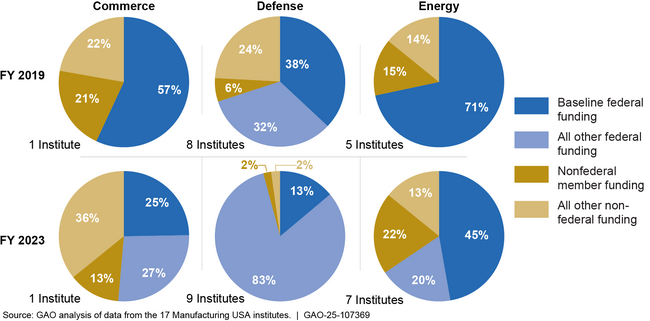Advanced Manufacturing: Aligning Strategies and Improving Agency Reviews Could Help Institutes Achieve National Goals
Fast Facts
Advanced manufacturing quickly turns new materials and methods into products, like airplane parts 3D-printed on demand. The Manufacturing USA Program connects businesses, academic institutions, and others through 17 institutes that do research and development and train workers. The Departments of Commerce, Defense, and Energy sponsor the institutes—whose work can lead to new technologies.
We found agencies could improve how they work with the institutes. Specifically, Defense and Energy can take a long time to review some institutes' project funding requests—which can delay or deter new projects.
Our recommendations address this issue and more.

Highlights
What GAO Found
The Departments of Commerce, Defense (DOD), and Energy (DOE) coordinate the Manufacturing USA Program and sponsor its institutes. Institute members, such as manufacturers and universities, help fund the institutes and conduct advanced manufacturing research and development (R&D) and workforce training. Key changes to the Program since FY 2019 included establishing new institutes—expanding the network from 14 to 17, as of December 2024. Also, Commerce formed a task team with DOD and DOE to continue implementing GAO's prior recommendations to develop networkwide performance metrics. Another task team has begun developing common policies on membership by entities from China or other countries of concern.
Commerce led the update of the strategic plan for the Manufacturing USA Program released in October 2024. However, Commerce officials described challenges. Specifically, the planning cycle required in statute does not align with mandatory 4-year updates to the National Strategy for Advanced Manufacturing. Aligning the strategic planning timeframes could better ensure the Manufacturing USA Program plan reflects the priorities of the national strategy.
The 17 institutes generally increased their overall funding, memberships, technical capabilities, and activity on R&D and workforce training projects. In general, the institutes diversified their funding sources away from sponsoring agency baseline funding by also obtaining other federal funding, such as federal awards for certain projects, and nonfederal funds, like membership dues.
Change in Manufacturing USA Institute Funding Sources, by Sponsoring Federal Agency, Fiscal Years (FY) 2019 and 2023

The six selected institutes and 22 members GAO interviewed described institutes' progress toward developing new technologies, building supply chain resilience, or other advanced manufacturing goals. However, they identified challenges, including long, uncertain timeframes for DOD and DOE to review some institutes' requests to fund new projects or membership applications. By not tracking review times, DOD and DOE could delay institutes' progress toward advanced manufacturing goals or discourage members' participation.
Why GAO Did This Study
Advanced manufacturing uses cutting-edge tools, methods, and materials to create high-value products, such as 3-D-printed aircraft parts. Congress established the Manufacturing USA Program in 2014 to stimulate U.S. leadership in advanced manufacturing, mainly through a national network of public-private partnership institutes.
Congress included a provision for GAO to report periodically on the Manufacturing USA Program. This report examines Program changes since fiscal year (FY) 2019, including in institute funding, and the extent to which institutes helped achieve advanced manufacturing goals.
GAO reviewed documents and data from the agencies and 17 institutes and interviewed agency officials and representatives of six institutes and 22 members. GAO selected agencies' oldest institutes, as they had the most time to achieve the goals.
Recommendations
GAO recommends Congress consider amending certain statutory requirements to better align Manufacturing USA's strategic planning timeframes with those for updating the National Strategy for Advanced Manufacturing.
GAO recommends that DOD and DOE track timeframes for reviewing project funding or membership application requests and analyze the information for potential improvements. The agencies generally concurred with the recommendations.
Matter for Congressional Consideration
| Matter | Status | Comments |
|---|---|---|
| Congress should consider amending Section 34 of the National Institute of Standards and Technology Act to require the Advanced Manufacturing National Program Office in Commerce to update the strategic plan for the Manufacturing USA Program on a timeframe that aligns with the timeframe for updating the National Strategy for Advanced Manufacturing. (Matter for Consideration 1) | As of June 2025, Congress has not taken action to align the timeframes for updating the strategic plan for the Manufacturing USA Program and the National Strategy for Advanced Manufacturing. |
Recommendations for Executive Action
| Agency Affected | Recommendation | Status |
|---|---|---|
| Department of Defense | The Secretary of Defense should ensure that the Office of the Under Secretary of Defense for Research and Engineering and the other appropriate DOD organizations track the timeframes for reviewing Manufacturing USA institutes' project funding requests and analyze the information to identify and, as appropriate, implement potential process improvements. (Recommendation 1) |
DOD concurred with this recommendation. We will provide an update after receiving information from DOD on planned steps to implement it.
|
| Department of Energy | The Secretary of Energy should ensure that the Office of Energy Efficiency and Renewable Energy tracks the timeframes for reviewing Manufacturing USA institutes' project funding and membership requests and analyzes the information to identify and, as appropriate, implement potential process improvements. (Recommendation 2) |
In commenting on our report, DOE stated it would develop a process to track the time it takes to process new membership renewals, project and work product reviews, award modifications, and will analyze the data to assess how to process these actions within shorter timeframes without affecting review quality. DOE planned to develop the process to track timeliness by July 2025 and anticipated completing its first assessment of the data to identify potential process changes by December 2025. We will assess and provide an update on this recommendation after DOE provides information on the implementation of these actions.
|
